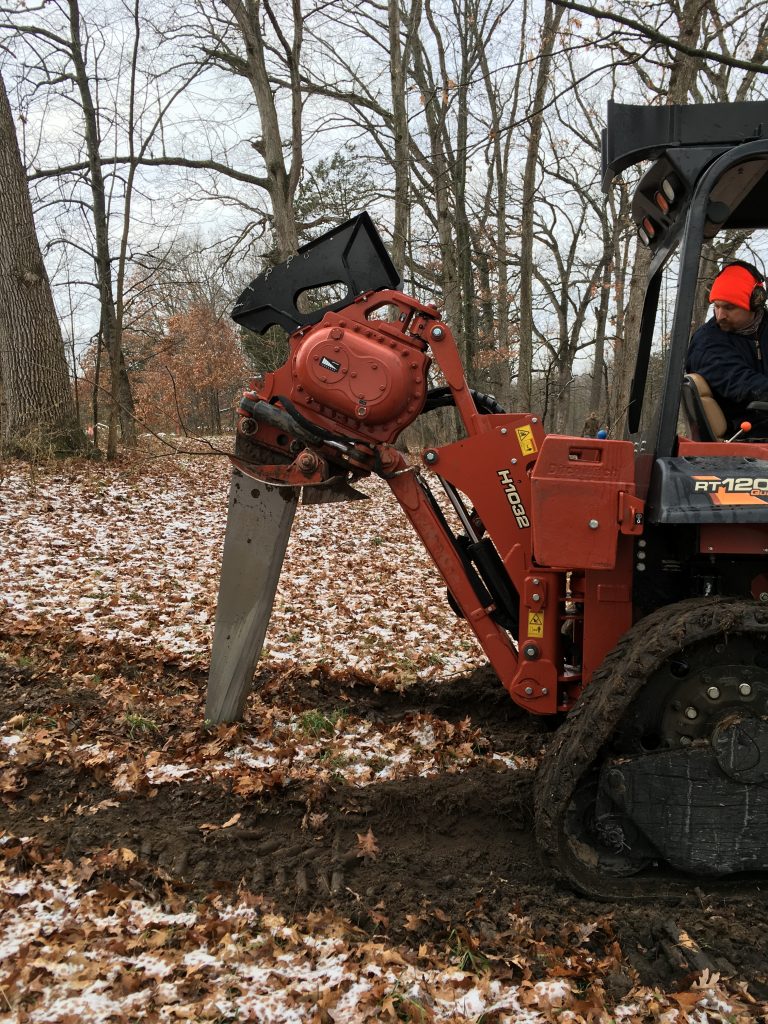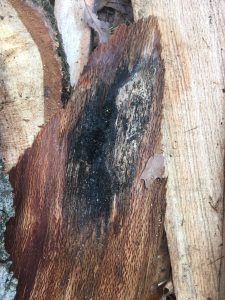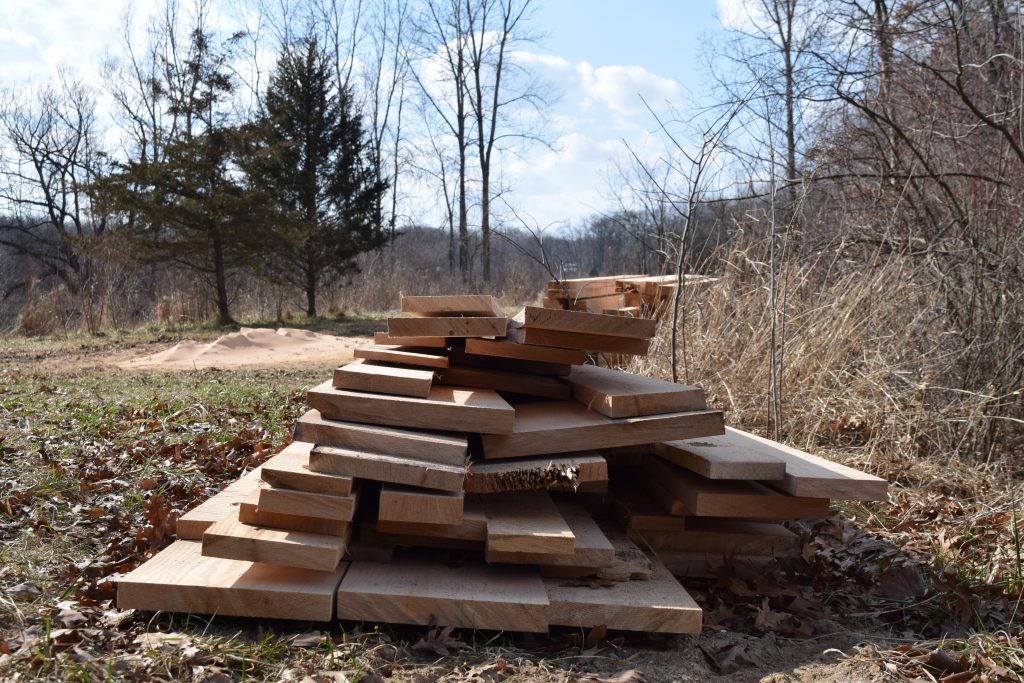By Allene Smith, Land Steward
When I left you last, Legacy was gathering information and planning our approach to managing oak wilt, a disease that kills red oaks (See Part 1, Getting ahead of oak wilt). Here’s the progress we’ve made since then.

Land Protection Coordinator Remy Long digging a trench around the infected area to sever the root systems that spread oak wilt.
In keeping with the Forest Management Model for oak wilt developed by Dr. Johann Bruhn, we first cut a 5-foot-deep trench around the infected oaks. The trench separated the root systems of trees that are or may be infected with oak wilt (inside the trench) from those that are still unaffected (outside the trench). We cut the trench with a huge blade—specially designed by the Michigan Department of Natural Resources (MDNR) for managing oak wilt—attached to an 18,000-pound Ditch Witch.

Land Steward Allene Smith with the huge blade designed for oak wilt trenching. Including the part embedded in the ground, it’s 5 feet long!
The next step is to cut down all trees in the red oak group growing within the trench line. For us, that meant 63 red and black oaks. Many of the trees appear healthy, but there is a good chance the fungus has already reached their roots so the cautious approach is to cut them down. In consolation, MDNR oak wilt expert Phillip Kurzeja offered, “If you feel like you’re cutting down a lot of trees, you’re doing it right.”
Note: It is very important to sever shared roots before removing infected trees. When an infected oak is cut down, surrounding healthy oaks who share roots with the infected tree take up the pathogen, spreading the disease faster.

Milling the trees to remove and safely store the infected bark onsite.
At about this point we experienced a January thaw. As the January thaw bled into a balmy February, the abrupt end to winter weather meant that loggers and tree services were hesitant to take on the job. The best practice is to avoid working near oaks during warm weather when nicking a tree can spread the disease. Warmer temperatures also accelerated pressure pad development. It became clear that we did not have the time or conditions to complete the project this season.

The bark and unmillable wood are tightly covered to prevent spread of the disease as the weather continues to warm.
So, we did the next best thing. We hired a local tree service to cut down the three trees killed by oak wilt last summer, each of which would produce spores this spring. Once cut, we hired a sawyer to debark the trees on-site using a portable sawmill. We covered all bark removed from those trees and any remaining unmillable wood with plastic, burying the edges to prevent curious picnic beetles from finding their way to the wood.

A pressure pad, a sign of the disease’s advancement on the infected trees we removed.
And we finished just in time! The wood we covered was pungent with the yeasty smell of oak wilt. We even found some pressure pads. Happily, I’ve not yet seen any sap-feeding insects flying around (and I’ve been looking).
The milled lumber is not infectious and will go toward a good use. In May, University of Michigan students in a Green Building class will use the salvaged oak lumber to construct a straw bale building at the University’s Biological Station in Pellston. Associate Professor Joe Trumpey says this will likely be the first student-built university building, and certainly the first university building of its kind, in U of M’s 200-year history. In the midst of an ecologically saddening project, this fortuitous partnership is a silver lining.

The silver lining: University of Michigan Green Building students will make good use of the lumber, which is not infectious.
Tune in for the next installment of our oak wilt saga, in which I’ll dish about the removal of the remaining trees. In the meantime, if you have any questions about oak wilt or how Legacy is managing the disease, please get in touch. Better yet, join us for an Oak Wilt Workshop on April 28 from 2-4 pm. Email [email protected] for details or to register. Thanks for reading, and remember: warm temperatures mean it’s time to stop pruning oaks!
P.S. Unexpected claims on time and financial resources are the same at a nonprofit as they are for a household: does this new wrinkle (like a leaky roof or a failing furnace) strain this year’s budget? How much do we need to budget for next year to continue addressing the problem, and what might we have to put off? While unrestricted giving to Legacy provides the most flexibility in allocating resources where they’re needed, supporters who are able to direct an additional gift to our Stewardship fund will help balance the extra demand that oak wilt remediation will continue to place on our resources over the next 12 months. Click the green Donate Today button above or call 734-302-5263 if you’d like to support this essential work. Thank you!

 RSS Feed
RSS Feed
What a complicated project especially with our weird winter weather – and it is so important to control oak wilt. Masterfully done. It looks like a lot of work – not yet finished, a lot of willing hands, successful management. Thanks Land Steward Allene Smith and the Legacy team of staffers and volunteers who supported the project. So – looking at the photo – that’s a pressure pad? Sounds like an outer space landing dock, looks like a crushed mushroom, and defines deadly. Keep me posted!
This latest installment of oak wilt education prompted a reader question regarding oak wilt in white oaks, and whether they might be targeted by the disease where red oaks aren’t available. In response, Land Steward Allene Smith has this to say:
“While only time will tell if our white oaks become more susceptible to oak wilt in the future, one factor tips the scales in their favor. When a white oak discovers it is under assault, it begins creating blockages (called tyloses) within its vascular system, limiting the pathogen’s ability to spread throughout the tree. Red oaks, however, develop tyloses slowly and not as effectively as white oaks. Consequently, the disease moves through red oaks quickly and always results in death, while a healthy white oak may be able to hold the disease at bay for several years, and perhaps survive the infection entirely. The relative immunity of white oaks is not simply because the disease hasn’t targeted them yet, but instead a product of their particular physiology.”
If this new information has prompted more questions, feel free to contact Allene at [email protected].
Its so interesting, but makes perfect sense, that an infected tree that shares roots with a healthy tree can spread the disease if the roots aren’t severed before removing the tree. Everything is interconnected – whether it’s good or bad. Thanks for the post and wonderful information!
Pingback: May Is Oak Wilt Awareness Month – Legacy Land Conservancy | Ann Arbor, MI
Thanks for spreading the word about Oak wilt and ways to prevent it!